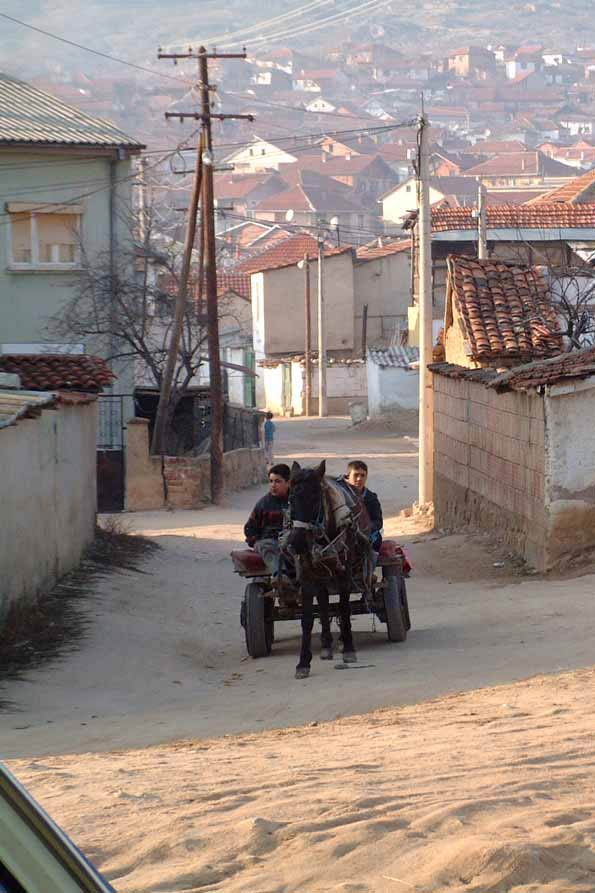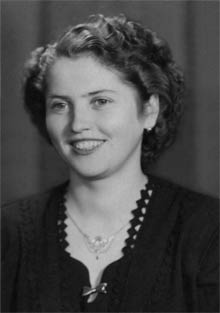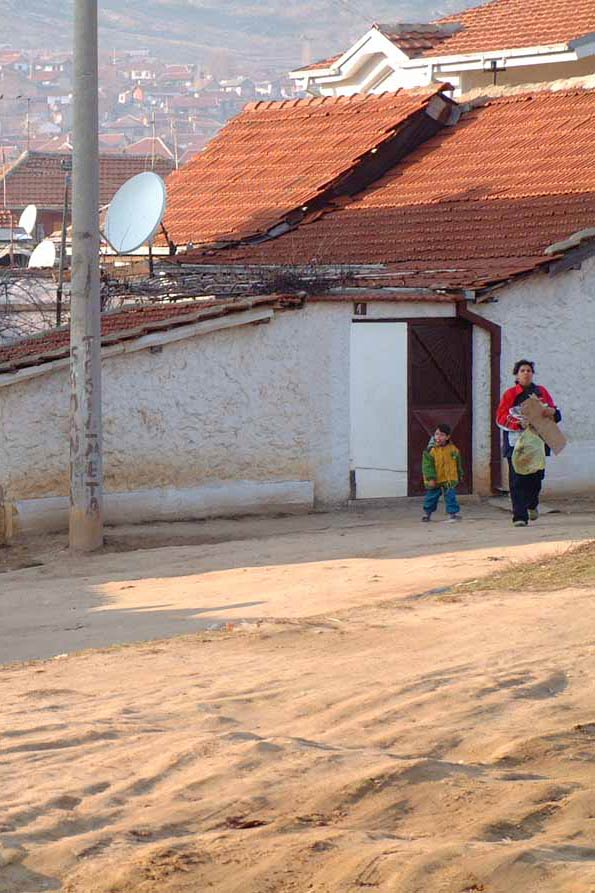φ21°33', λ41°21'
Ecology Information No. 6
October, 2009
|
|
THE SKIN OF PRILEP ENVIRONMENT
The symbolic meaning of the above formulation is evident and easily recognizable, pretending to create a comprehensive picture of everything that is visible and that can be received not only by God's given senses, by nature itself, but also by delicate soul which is in harmony with nature, with development of thought and ratio, with social pogroms, the traces of which cause pain even in a dream, beyond the consciousness, forever.
And whose is "the skin of Prilep area", then, if not of those who dwell here, who wear it everywhere as a cloak on their backs and every single touch activates numerous sensors, one by one or all of them together. In this way, the nature and man make a unity that should, but doesn't have to be realized.
Unfortunately, it happens to us quite frequently. Not because of the "skin" of the area, but because of us, our imprudence, the egoism maybe, or some uncontrolled destructive power which destroys everything on its way, including the man in ourselves
But this "skin" does not look like something it could have been in some other, conditionally different occasions. Especially not in the field of literature. This is due to a variety of reasons. First of all, literature has words and language as its expressive devices, denoting in the same time the national specificity, something that have always been denied in the Balkans. Literature can be also very applicable in realization of some special aims, which do not have to be necessarily of literary-esthetic origin, but still satisfy some criteria that are an outcome of certain centers of power which have - to tell the truth - always been there, either explicitly opened or perfidiously hidden.
Therefore, when it comes to the written heritage of this biblical country, including the Prilep area, its "skin" and roots, the things found deeply beneath it, the living tissue which is bleeding so frequently, historical and social circumstances have always been of crucial importance. So, literature is not always what it should stand for. It loses its artistic function and often becomes just an instrument, a tool which is used to make a rough and deep cut right to the bottom of national and ideological template opposite to some others interests.
Because of the language, many literary efforts in the past took the flak, and later on, in conditions of the alleged socialism, every critical interpretation of social reality was violently condemned.
In spite of this, in the mid 1950's, in Prilep, in almost miserable conditions, a group of enthusiasts initiated publication of the literature journal "Stremez" (Aspiration). More precisely, this journal on literature, culture and society was promoted in 1956 or 1957, on the initiation of Bosko Babic, Zivko Vasileski, Lidija Ezova, Branislav Kuleski, Lazo Karovski, Gjore Napeski and Mile Poposki. By this act, slowly and officially, conditions were made to create adequate space for this kind of art and its authors. Not denying its good intentions and historical impact, however, it could not protect itself from some "childhood diseases". In the first place this includes sociopolitical circumstances which, like in all other journals published in the general climate of reconstruction of the country and the engrafted socialistic idea, were guided from a single center of power that brought decisions and principles what and how to write. For this reason, it was impossible to publish, regardless of its esthetic values, something more delicate and opposite to the mainstream politics. It was particularly unimaginable for the texts with strongly expressed national thought, because the limit between national and nationalism was extremely thin and not clearly defined.
Prof. Vasile Dimeski |
 Natasa Jaric,
2006 
Blaga Nikoloska,
photo ZRAK, 1953 | | 
Daisy Ilina Nikoloska,
photo Petre Nikoloski, 2000 |
THE RACIAL AND RELIGIOUS COOPERATION AND TOLERANCE IN THE MUNICIPALITY OF PRILEPEach multicultural society has its specific political philosophy and political doctrines in organization of the state. The Republic of Macedonia is a good example of multicultural society. The term multiculture denotes existence of a number of communities differing from each other by race, nationality, language, customs, tradition and religion and also by the values they appreciate.
In this sense, municipality of Prilep is a small world. Beside Macedonians as majority population, other national minorities living on the territory of Prilep and the surrounding villages are: Turks, Bosniaks, Albanians, Serbs, Croats, Bulgarians, Vlachs, etc. According to statistical data, the most represented national minority in the town are the Romani people. The number of representatives of other races is negligible: few Blacks, 2-3 Asians - and that is all.
Like all other national minorities in the Republic of Macedonia, those in Prilep Municipality enjoy their constitutionally guaranteed rights that can be divided in several types: lingual, religious, cultural, educational, including the rights related to the local government and public administration.
In places where national minorities make the majority of population, the educational process in the elementary school is held in their native language.
With regard to their cultural rights, the Romany people in Prilep have their folk ensemble and a NGO which stands for their affirmation in political structures, educational needs of Romani children, compulsory medical protection, vaccination of children, education of women for prevention of unwanted pregnancy and many other problems of this population, including the major one - unemployment
The Local Government of Prilep Municipality made efforts to improve the life of Romani people living in the periphery of the town, by completing their electrification, sewerage and water-supply system.
For surrounding villages settled by other nationalities, the Government supplied free transport for the pupils attending secondary school in Prilep.
With regard to religious rights, there are religious objects in all villages settled by representatives of the above mentioned nationalities. There is also a plan to reconstruct the Mosque in the center of the Old Bazaar, burned down during the conflict in 2001
It can be concluded that, except for some individual incidents, there have been no serious problems among different national and religious groups in Prilep Municipality. The citizens of Prilep accept the differences in the name of peace, tolerance and coexistence. This is most vividly expressed through their mutual respect for religious holidays of the others. Thus, in the days of Kurban Bairam and Ramazan, Macedonians pay visits to Muslims and vice versa: for Christmas and Easter, Muslims pay visit to the orthodox Macedonians.
Through the history and up to the present, in democratic Macedonia, Prilep and its citizens have proved that coexistence and respect is a clue for good organization of the town. Down in the Old Bazaar many languages are spoken, many commodities and services are offered; one nationality makes jokes on account of another, and nobody gets angry. There is mutual respect and good will, and the incidental conflicts are usually a result of other reasons which have nothing in common with racial or religious intolerance. Finally, I would like to mention the Taiwan restaurants that have recently been opened in Prilep. Their owners are representatives of the yellow race, who live and run a successful business in the town.
The Republic of Macedonia is multiethnic society founded on the principles of democracy, and Prilep is a typical Macedonian town in which one can observe and feel all advantages of multiculturality in every sense of the word: racial, religious, national and cultural. Just like in a school example.
Rozita Gagaleska,
professor of sociology and civic society
|
 | photo, Vlatko Ivanoski,
Foto studio Rival, 2009 |
THE THEATER IN PRILEP
The earliest documented materials of organized theater life in Prilep date from 1887 and they are connected with educational activities of the Church in Prilep. Namely, in September 13, 1887, the school authorities appointed the teacher Atanas Badev a principal of the recently established municipal theater, and the first performance was played in October 20 the same year. It was Molier's comedy "The Doctor in spite of himself", performed by an amateur ensemble of local teachers and older students, who played both male and female roles. Director of the play, set designer and prompter was Mr Badev himself.
The first professional theater in Prilep was founded in autumn 1949, by the Decision of National Council of the town of Prilep. The institution, officially named Gradski Naroden Teatar Prilep (Prilep City Theater) employed 13 regular and 10 honorary actors. Its first manager was Rampo Koneski - amateur with a long theater experience. The premiere performance was the comedy "Kir Janja" by Jovan Steria Popovic and it was held in February 18, 1950, with Ace Mihajlovski as director.
The year 1954 was a turning point in the history of Prilep Theater. That year the theater building was adapted and the artistic ensemble was enforced with a larger group of actors from Skopje, headed by director Mirko Stefanovski. In the six years that followed (1954 - 1960), this Theater, under the leadership of Mirko Stefanovski, became one of the most dynamic, most intriguing and most successful Macedonian theaters.
In 1965, the Prilep Theater organized and hosted theater games "Vojdan Cernodrinski", which later developed into Macedonian Theater Festival.
In years between 1950 and 2000, the National Theater "Vojdan Cernodrinski"-Prilep put on 200 premieres with over 4000 performances, watched by over one million spectators.
All these data are written in the history of theatrical art of Prilep. But where is Prilep Theater today? This is the question that should be asked by every artist, in the eyes of the public. Theater is the only art which happens live, while we watch it, and than it disappears. The only thing that remains is memory about the act. Therefore, it is of highest importance for the theater to take constant care about its purity, primarily mental and creative, and than physical. And which is the answer to these questions? How many questions are still waiting to be answered? What is the actual status of the theater? The presence reveals some unpleasant facts. The truth is painful and disappointing: worse and worse working conditions, weaker and weaker production of plays, fewer and fewer audience.... Things to be worse, it's nobody's fault! Everyone depends on everyone. The mere essence of the theater is team work of producers, artists, techniques, audience etc. But, somewhere, the Circle has been broken. And it is not a circle if it's not round.
This is the present. If we look into the future, we can see some beams of hope. Like never before, there is an influx of young professional actors prepared to leave deep traces in Macedonian culture in the years to come. We can only hope that these offshoots will not become victims of political competition between the parties which dictate and create the cultural life in Macedonia.
Vladimir Gjorgjijoski,
actor
|
 Natasa Jaric,
2006
|
|





